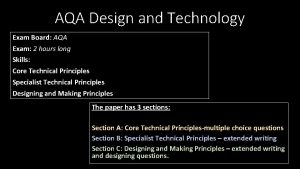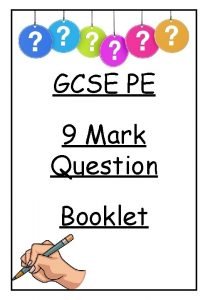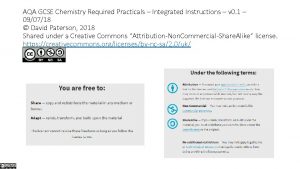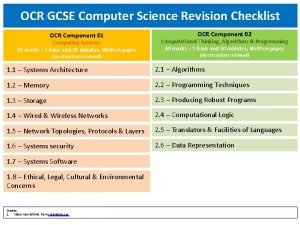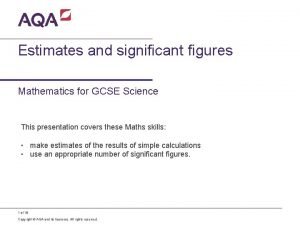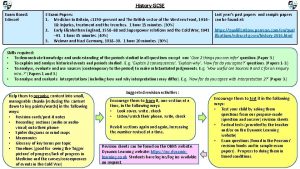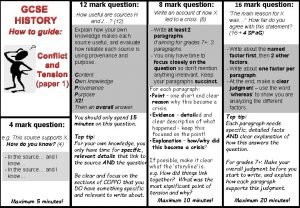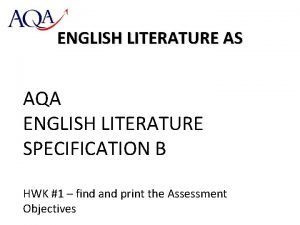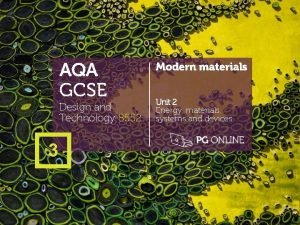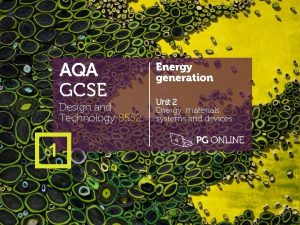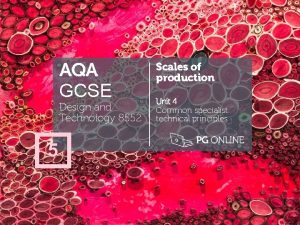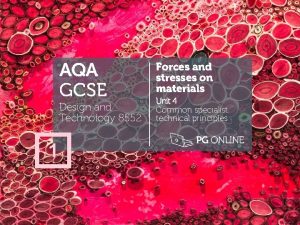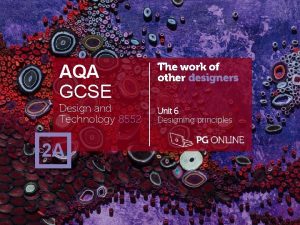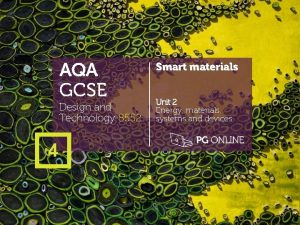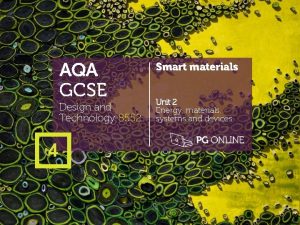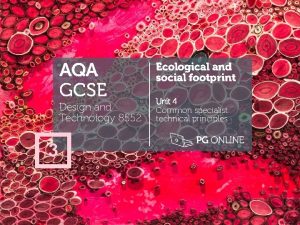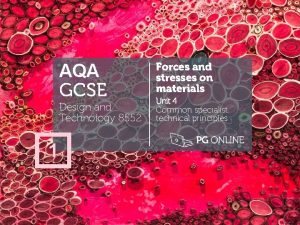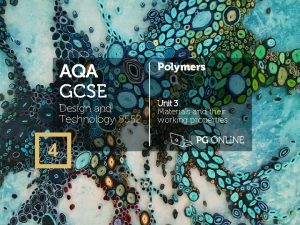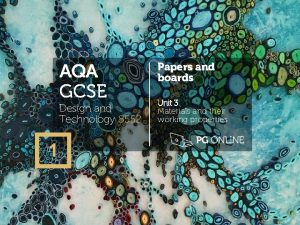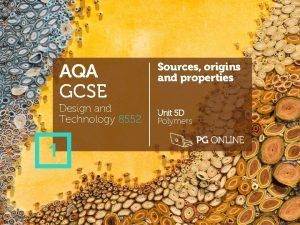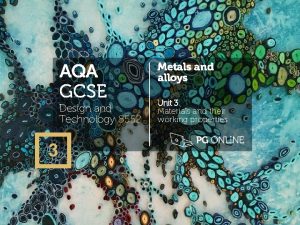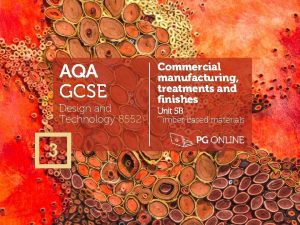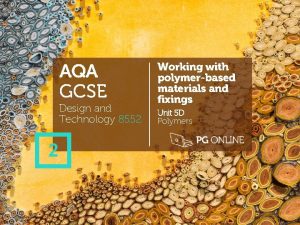AQA GCSE Design and Technology 8552 3 Modern


















- Slides: 18

AQA GCSE Design and Technology 8552 3 Modern materials Unit 2 Energy, materials, systems and devices

Objectives • Be able to recognise a range of modern materials • Describe developments made through the invention of new or improved processes involving modern materials • Explain how modern materials can be used to alter functionality

Modern materials Unit 2 Energy, materials, systems and devices Modern materials • New and improved materials are constantly being discovered and developed • Modern materials can help to solve: • design issues • technical constraints • environmental issues • Which non-stick modern material is used to coat some kitchen equipment?

Modern materials Unit 2 Energy, materials, systems and devices What is a modern material? • Modern materials are new inventions or one that has been relatively recently discovered • A material or element may also be used or combined in a way that is different from its normal function • It might be blended, coated, alloyed or treated to improve its functional or aesthetic properties • Which modern security features do many new bank notes have?

Modern materials Unit 2 Energy, materials, systems and devices Biodegradable polymers • Biodegradable polymers are made from vegetable starches, often corn-starch • Common varieties include: • Polylactic acid (PLA) commonly used in 3 D printing filament • Polyhydroxybutyrate (PHB) under the trade name Biopol. TM • Polycaprolactone (PCL) known as Polymorph • Why might some biodegradable polymers struggle to decompose in a landfill site?

Modern materials Unit 2 Energy, materials, systems and devices Did you know…? • The Saltwater Brewery (Florida USA) used wheat and barley remnants from brewing their beer to make 100% biodegradable, compostable and edible six-pack rings • Discuss which other commonly thrown away plastic products could benefit from being made from such a modern material

Modern materials Unit 2 Energy, materials, systems and devices Polymorph and Coolmorph. TM • Polycaprolactone (PCL) is a low temperature, hand-mouldable polymer • Polymorph fuses at 62°C, although Coolmorph. TM bonds together at just 42°C making it easier to use • They are both biodegradable, non-toxic and can be coloured • They are ideal for modelling as they can be shaped using only hand pressure • They can be reused and remoulded multiple times • How could PCL be used to make repairs to household items?

Modern materials Unit 2 Energy, materials, systems and devices Flexible MDF • Flexible MDF allows for the creation of natural curves • It is commonly used in the design of shop fittings and bespoke commercial projects • Routed or machined grooves enable the material to bend • Name an alternative flexible timber-based material?

Modern materials Unit 2 Energy, materials, systems and devices Titanium • Although a chemical element, titanium is commonly alloyed with other metals • It is relatively lightweight, tough and stiff with low density • It has excellent corrosion resistance making it very versatile • Titanium does not react with the human body, making it ideal for medical applications • Where might a metal with these properties be useful?

Modern materials Unit 2 Energy, materials, systems and devices Fibre optics • Fibre optic cables carry light down a thin glass core • Uses include: • Cable TV and broadband infrastructure • Medical applications using endoscopes to allow doctors to see into the body • Fun optoelectronics and novelty goods • How could this technology be beneficial to the Police and the Military?

Modern materials Unit 2 Energy, materials, systems and devices How thin? • Imagine a material one atom thick that is: • 200 x tougher than steel • stretchable and flexible • transparent yet impermeable • highly electrically conductive • What could this be? • How might it be used?

Modern materials Unit 2 Energy, materials, systems and devices Graphene • Graphene was accidentally discovered in 2004 • Research into the uses of graphene is currently active in many areas including: flexible electronics, biomedicine, energy storage and composite materials • Scientists are very optimistic about its future applications • How could flexible electronics benefit the consumer? • How could lighter and tougher materials assist the elderly or disabled?

Modern materials Unit 2 Energy, materials, systems and devices Liquid Crystal Display (LCD) • LCDs come in monochrome and full colour versions • Screens can be very small and lightweight • Bespoke monochrome layouts can be achieved • They have very low power consumption • LCDs do not emit light, so they require back lighting • Colour versions use pixels • Where might you find LCDs in use?

Modern materials Unit 2 Energy, materials, systems and devices Nanomaterials • Exactly how small are nanomaterials? • From the chart below, you can see a grain of sand is roughly one million times larger than a nanometre • Nanomaterials range from 1 to 1000 nanometres • Nanomaterials benefit from their scale and increased surface area, but what do they actually do? Nanomaterial range

Modern materials Unit 2 Energy, materials, systems and devices Metal foam • Metal foams are very lightweight compared to solid metals • As little as 25% of the mass of the solid metal is used • The air pockets are made by injecting gas into liquid aluminium or titanium • They are 100% recyclable • How might metal foams be beneficial to the aircraft and automotive industries?

Modern materials Unit 2 Energy, materials, systems and devices Worksheet 3 • Complete the worksheet

Modern materials Unit 2 Energy, materials, systems and devices Plenary • Name two modern materials that can be shaped using heat • Which modern materials are currently in a very early stage of development? • Explain how biodegradable polymers reduce the amount of fossil fuel used in plastic manufacturing • Which modern materials can be used to improve strength-to-weight ratios and performance in the automotive industry?

Modern materials Unit 2 Energy, materials, systems and devices Copyright © 2017 PG Online Limited The contents of this unit are protected by copyright. This unit and all the worksheets, Power. Point presentations, teaching guides and other associated files distributed with it are supplied to you by PG Online Limited under licence and may be used and copied by you only in accordance with the terms of the licence. Except as expressly permitted by the licence, no part of the materials distributed with this unit may be used, reproduced, stored in a retrieval system, or transmitted, in any form or by any means, electronic or otherwise, without the prior written permission of PG Online Limited. Licence agreement This is a legal agreement between you, the end user, and PG Online Limited. This unit and all the worksheets, Power. Point presentations, teaching guides and other associated files distributed with it is licensed, not sold, to you by PG Online Limited for use under the terms of the licence. The materials distributed with this unit may be freely copied and used by members of a single institution on a single site only. You are not permitted to share in any way any of the materials or part of the materials with any third party, including users on another site or individuals who are members of a separate institution. You acknowledge that the materials must remain with you, the licencing institution, and no part of the materials may be transferred to another institution. You also agree not to procure, authorise, encourage, facilitate or enable any third party to reproduce these materials in whole or in part without the prior permission of PG Online Limited.
 Aqa fine art gcse
Aqa fine art gcse Aqa design and technology past papers
Aqa design and technology past papers Gcse pe 9 marker
Gcse pe 9 marker Gcse geography edexcel b revision checklist
Gcse geography edexcel b revision checklist Aqa history 8 mark question structure
Aqa history 8 mark question structure Aqa gcse chemistry required practicals
Aqa gcse chemistry required practicals Aqa religious studies gcse past papers
Aqa religious studies gcse past papers Aqa gcse maths revision checklist
Aqa gcse maths revision checklist Significant figures gcse
Significant figures gcse History past papers edexcel
History past papers edexcel Tangent questions
Tangent questions Aqa maths gcse revision guide
Aqa maths gcse revision guide 12 mark history question structure
12 mark history question structure Kendal industrial park aqa
Kendal industrial park aqa Aqa gcse english literature specification
Aqa gcse english literature specification Sample design and technology gcse examination paper answers
Sample design and technology gcse examination paper answers Sample design and technology gcse examination paper answers
Sample design and technology gcse examination paper answers Www.technologystudent.com
Www.technologystudent.com World association of technology teachers
World association of technology teachers

